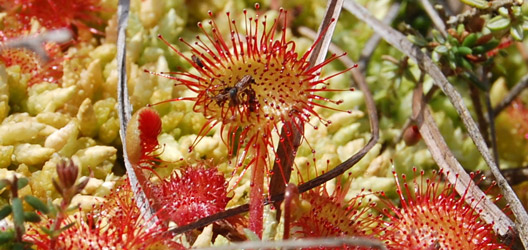Latest news from Loughborough University

16 Apr 2014
Colour isn’t key for carnivorous plants
The widespread belief that carnivorous plants are brightly coloured to attract prey could be wrong, according to the latest research published by scientists at Loughborough University.
Many carnivorous plants are bright red in colour, which is widely hypothesized to attract prey or provide camouflage. But a new study, published today in Royal Society journal Biology Letters, monitored capture rates of natural and artificial carnivorous species Drosera rotundifolia (commonly known as Sundew) and found the colour of the plant made little difference.
Sundews are one of the more common species of carnivorous plants, and typically grow in swamps, marshes and bogs across the temperate region of the northern hemisphere.
Dr Jonathan Millett and George Foot in the University’s Department of Geography’s Centre for Hydrological and Ecosystem Science undertook a study investigating the Sundew plant, whose red leaves catch prey using sticky glue secreted on the end of stalked tentacles.
Researchers conducted three separate studies on peat bogs at Thorne Moors in South Yorkshire to determine the role of plant colour in attracting prey.
They designed artificial traps to isolate the influence of colour and observed living plants in their natural habitat, and capture rates were logged. Findings showed prey were not attracted to green traps, and were actually deterred from red traps. There was no evidence the camouflaged traps caught more prey.
This is one of the first studies to provide conclusive proof the plants’ red colour has not evolved to attach prey, which suggests the vivid colouring may serve another purpose.
Dr Millett said:
“Prey attraction to red carnivorous plant traps is yet to be conclusively demonstrated for any species.
“Our results suggest that the red pigments called anthocyanins, which create these bright colours, might serve a different role in the biology of the plants.
“This is an important step in helping us understand the evolution of carnivorous plants, and how they work.”
Dr Millett is now investigating the true role of the anthocyanins, which he believes might act as a sunscreen to protect the plants from the dangerous effects of the sun.
Notes for editors
Article reference number: PR 14/74
Loughborough is one of the country’s leading universities, with an international reputation for research that matters, excellence in teaching, strong links with industry, and unrivalled achievement in sport and its underpinning academic disciplines.
It was awarded the coveted Sunday Times University of the Year title in 2008-09 and has been named Sports University of the Year 2013-14 by The Times and Sunday Times. Loughborough is consistently ranked in the top twenty of UK universities in the Times Higher Education’s ‘table of tables’ and has been voted England's Best Student Experience for six years running in the Times Higher Education league. In recognition of its contribution to the sector, Loughborough has been awarded seven Queen's Anniversary Prizes.
In 2015 the University will open an additional academic campus in London’s new innovation quarter. Loughborough University in London, based on the Queen Elizabeth Olympic Park, will offer postgraduate and executive-level education, as well as research and enterprise opportunities.
Contact for all media enquiries
Amanda Overend
Public Relations Officer
Loughborough University
T: 01509 223491
E: A.J.Overend@lboro.ac.uk